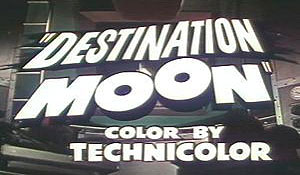
The Red Menace was a real concern in 1950 when George Pal’s Destination Moon became the template for a decade of science fiction movies. Hailed for its then unheard of two-year production time, this film laid a prescient for the Space Race a full seven years before the real struggle became a reality with the U.S.S.R.’s launch of Sputnik.
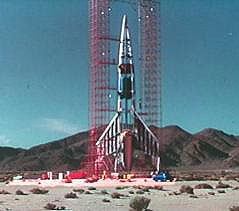
The movie begins with two men, Dr. Charles Cargraves (Warner Anderson), the scientist-engineer who designs rockets and satellite payloads, and General Thayer (Tom Powers), the military man who fights for the appropriations for space projects. Both are in a bunker, awaiting the liftoff of their rocket that they have struggled to bring to reality. The machine barely clears the pad before plummeting to earth and exploding.
Cargraves, knowing his design was perfect, realizes the failure was due to Communist sabotage. Thayer agrees, but also realizes this means the end of the rocket program and his military career. The government can’t see past the immediate or realize the long-term benefits from the space program.
Two years later, Thayer visits Jim Barnes (John Archer), a wealthy industrialist who manufactures planes, negotiates the revival of the US space program through a commercial base. Thayer explains that private industry could design and build a rocketship in a fraction of the time it would take a government program to create one. Since his failed launch two years earlier, Cargraves has perfected an atomic engine that will not only allow them to escape Earth’s gravity but also travel to the Moon. Barnes hesitates at first until he learns that the Communists are also trying to obtain the same goal.
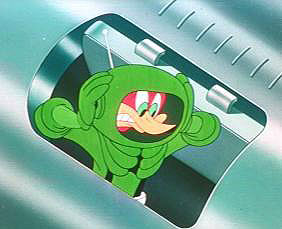
In a great bit of movie nostalgia, the concepts of space are explained through a Woody Woodpecker cartoon in which Woody demonstrates the principles of physics and space travel. This cute moment is broken by Thayer’s announcement that if the communists get to the Moon first, they will set up missile bases there that will threaten the entire free world.
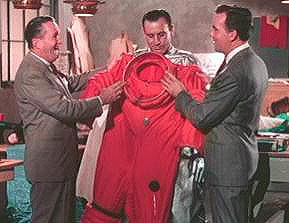
The rocketship is built in record time but the team isn’t allowed to test their atomic engine anywhere outside the South Pacific, where nuclear testing was already underway. Lacking the funds to move the test operation outside the United States, Barnes, Thayer, Cargraves, and the guy who designed and installed the radio and radar systems climb aboard and decide to launch to the Moon without government approval. Well, the radio guy has an assistant, Joe Sweeney (Dick Wesson), who is quickly pressed into duty. Joe is a wise-cracking Brooklyn guy brought along simply to provide comic relief. The rocket launches, seconds ahead of a court order forbidding the operation and we get some great exposure to G-forces contorting the crew’s faces.
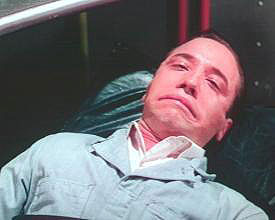
Throughout the journey, the team takes great pains to explain the intricacies of space travel to Joe who serves as the surrogate for the then ill-informed audience. The film introduces problems with eating in zero gravity and the use of gravity boots. All in all, the movie uses some fairly clever camera tricks to achieve its goal.
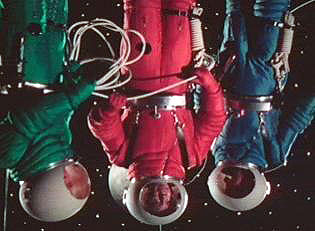
During the flight, the crew faces several problems. Ironically enough, these don’t include flying through a meteor shower, something mandatory in all space films at the time. Rather, they handle such difficulties as freeing the antenna that is frozen in place because Joe greased it prior to their launch, not realizing the grease would solidify in the cold of outer space. This provides the excuse for the crew to go EVA from their rocket, which in itself provides the excuse for Cargrave to get cast adrift, seemingly to float forever in the void. Of course, this provides the excuse for Barnes to use a spare oxygen tank as an improvised jet pack that allows him to move about and rescue Cargrave.
The moon landing proves to be rougher than expected as well. Barnes and Cargraves rush onto the lunar surface to claim the Moon as property of the United States and the good of all mankind, which includes denying access to the murdering, treacherous, godless Communists! Fortunately, this also involves getting American missile bases established on the moon to keep the red menace in check.
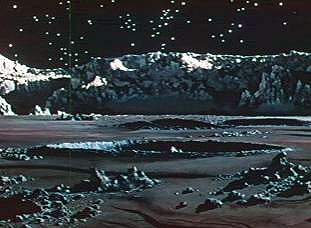
Perhaps the greatest tribute to Destination Moon is that nearly every space-faring movie for the next decade featured a spacecraft that was some variation of this film’s craft, the Luna. Although hardly original, the film followed Robert Heinlein’s Rocketship Galileo fairly closely, changing only superficial details of that story. It stressed brave American pioneers using the industrial complex for the betterment of their nation and showed a patriotic aspect that seems to have been totally reversed in modern times.
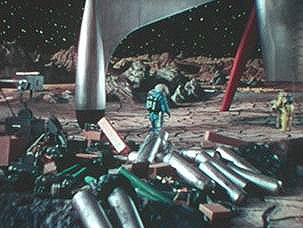
Although campy by today’s standards, Destination Moon seeks for the better qualities of ourselves and represents a better age, when both our social qualities and enemies were clearly defined.
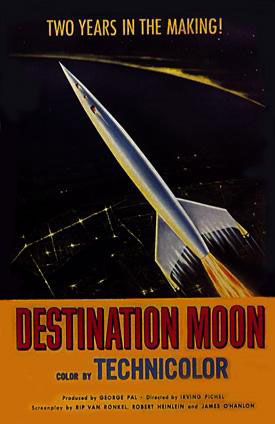
FILM DETAILS:
Destination Moon won the 1950 academy award for special effects.
The moonscape painting was considered the most impressive space scene ever seen on film.
The two-year production time was absolutely unheard of when the film was released.
– written by the Two-Brained Cylon